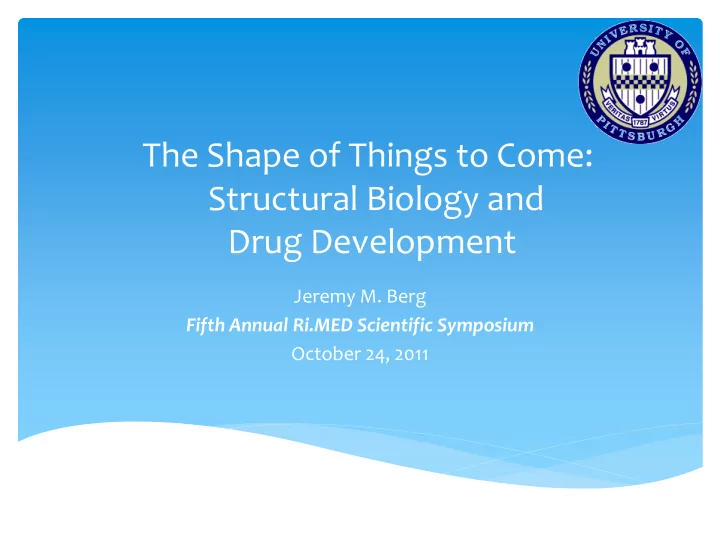

The Shape of Things to Come: Structural Biology and Drug Development Jeremy M. Berg Fifth Annual Ri.MED Scientific Symposium October 24, 2011
The Promise of Structure- Based Drug Design Knowledge of the 3-D structure of a drug target should allow design of molecules that bind to observed pockets
Challenges to Structure- Based Drug Design The energetics of protein-ligand interactions are complicated and nuanced Both proteins and ligands can be quite flexible Many target-binding ligands are not good drug candidates The structures of many important drug targets are difficult to determine
Protein-Ligand Binding Simplistic view
Protein-Ligand Binding Solvation
Protein-Ligand Binding Flexibility
Protein-Ligand Binding Dynamics
Iterative Structure- Based Drug Design
Compound Optimization Optimize binding affinity for target (based on structures) Additional considerations: Other measures of efficacy Specificity for target compared with other related proteins Physical properties (e.g. solubility) Bioavailability Ease of synthesis
HIV Protease
A Starting Compound
Iterative Design
HIV Protease-Drug Complex
Impact of HIV protease inhibitors in combination therapy
Progress in Structural Biology Protein Data Bank: Founded in 1971 for storing 80,000 structures crystallographic expected by end of 2011 coordinates 13 deposited structures in 1976
Challenges for Structural Biology: Membrane Proteins Physiologically important including many drug targets Difficult to express and purify to homogeneity Difficult to crystallize
G Protein Coupled Receptors Signaling proteins that act by stimulating the exchange of GTP for GDP in associated heterotrimeric G proteins Large family of membrane proteins characterized by the presence of 7 transmembrane helices Targets of approximately 40% of known drugs!
3-Dimensional Structure b -2 Adrenergic Receptor Cherezov et al. “ High-Resolution Crystal Structure of an Engineered Human b 2- Adrenergic G Protein-Coupled Receptor ” , Science 318 , 1258 (2007). 2.4 Å structure revealed residues 29-342 (out of 413), bound partial inverse agonist carazolol, bound palmitic acid, and three cholesterol molecules
3-Dimensional Structure b -2 Adrenergic Receptor Protein engineering Robotic system crystallization Microfocus beamline (Argonne National Laboratory) Culmination of two decades of effort by Brian Kobilka beginning with receptor cloning
b -2 Adrenergic Receptor Sequence
b -2 Adrenergic Receptor Structure
Carazolol Palmitate Cholesterol (X3) Maltose
Other G Protein Coupled Receptor Structures (Bovine rhodopsin) Human adenosine A (2A) receptor Human histamine H1 receptor Turkey b 1 adrenergic receptor Human dopamine D3 receptor
Progress and Challenges in Structure-Based Drug Design Iterative structure-based drug design is now a proven method Structures can guide medicinal chemistry to yield novel and efficacious structures
Progress and Challenges in Structure-Based Drug Design Accurate computational assessment of ligand affinities remains problematic Improved algorithms and enhanced computational power are available (Department of Computational and Systems Biology)
Progress and Challenges in Structure-Based Drug Design The structures of many potential drug targets are not known Progress on structure determination methods continues (Department of Structural Biology)
Peroxisomes Membrane-bound organelles House enzymes associated with: Hydrogen peroxide metabolism (catalase) Long chain fatty acid oxidation Plasmalogen, bile acid biosynthesis Purine catabolism
Peroxisomal Protein Targeting Targeting sequence: -SKL at carboxyl terminus Some conservative substitutions are tolerated: - (S,C,A)-(K,R,H)-(L,M)-COO - -GGKSKL -GGKAKL -GGKSKI
Peroxisome Biogenesis Machinery S.J. Gould and D. Valle, Trends in Genetics 16 , 340 (2000)
The Structure of Pex5p Pex5p Cargo protein First Pex5p structure previously solved by Greg Gatto, MD, PhD
The Human Peroxisomal Proteome Range of Pex5p-PTS1 Dissociation constants: 1.6 nM - > 25 m M Key proteins: Acyl-CoA oxidase 1: 5.6 nM Catalase: 1.2 m M Debdip Ghosh, PhD
The Glycosome Trypanosomes contain a novel organelle termed the glycosome A peroxisome variant housing the enzymes of the glycolytic pathway Trypanosomal Pex5p is a potential drug target to kill trypanosomes in the bloodstream of infected individuals
Peptide Binding by Human vs Trypansomal Pex5p Debdip Ghosh, PhD
Grazie! “You can observe a lot just by watching” Lawrence Peter “Yogi” Berra
Recommend
More recommend